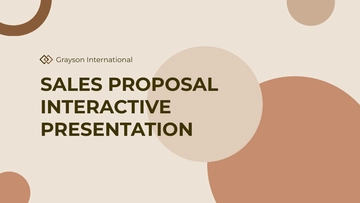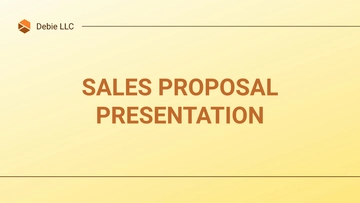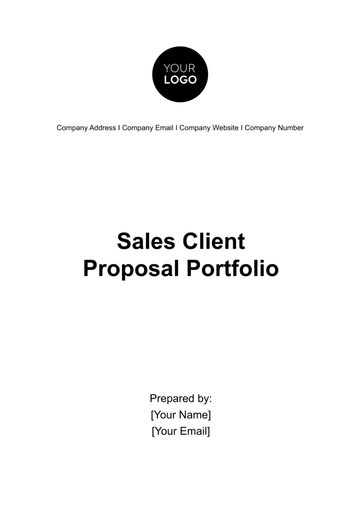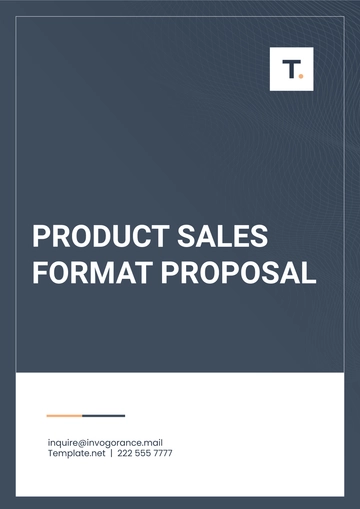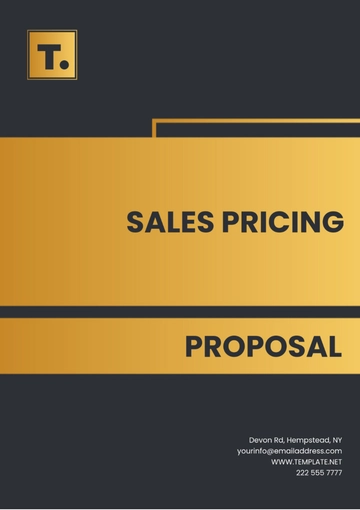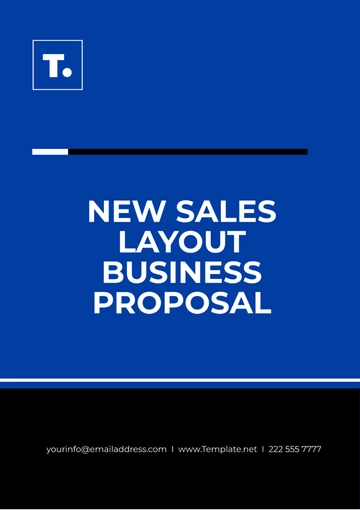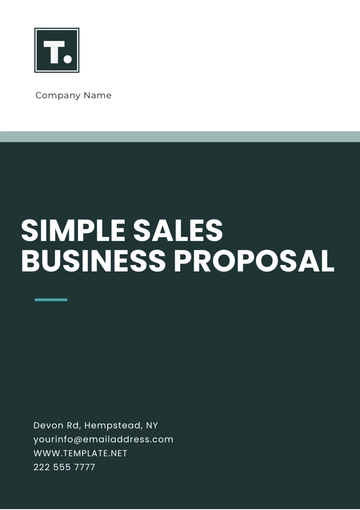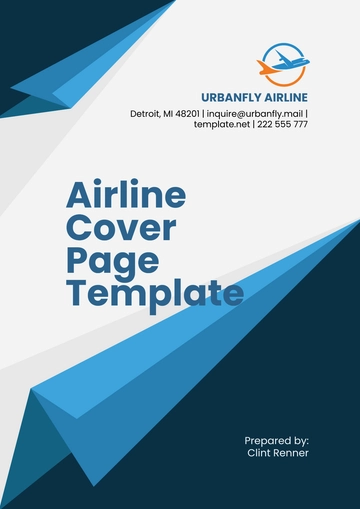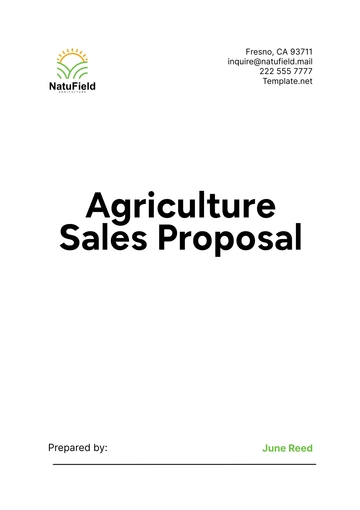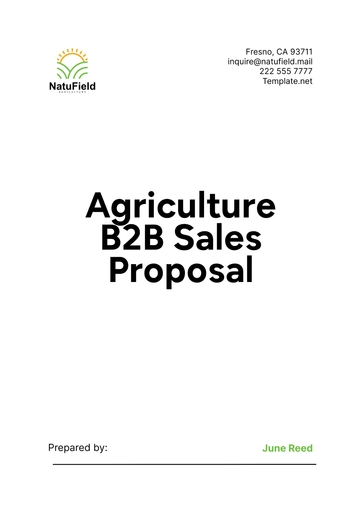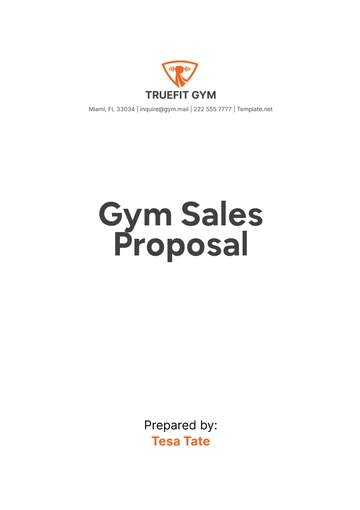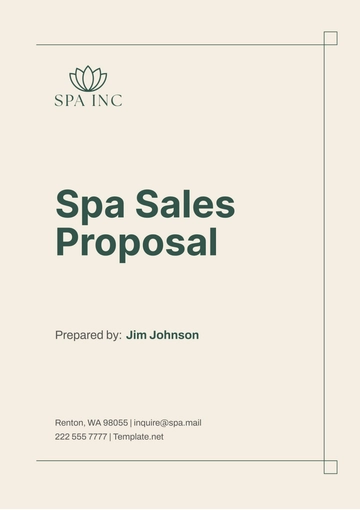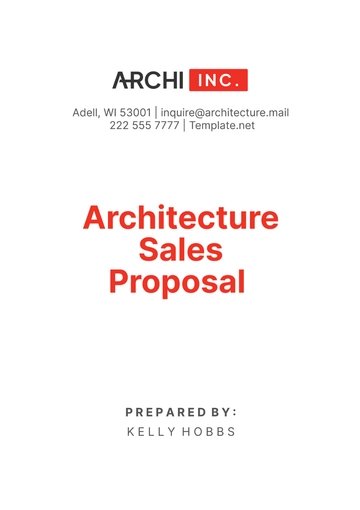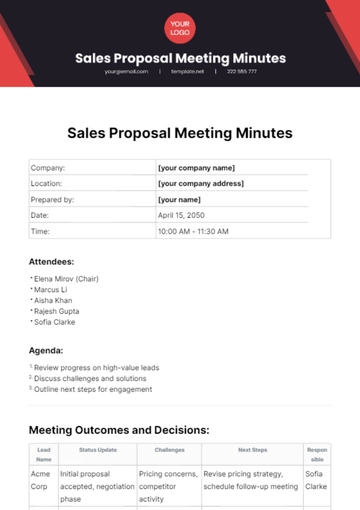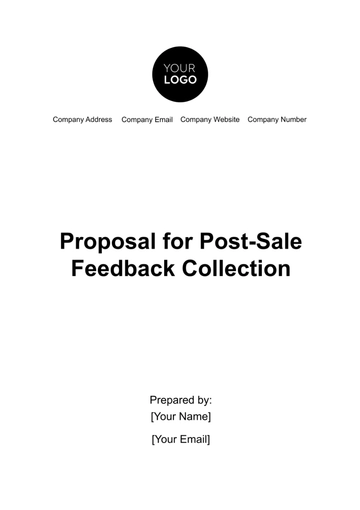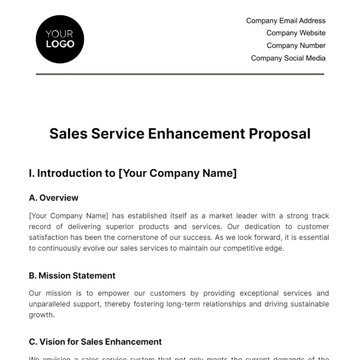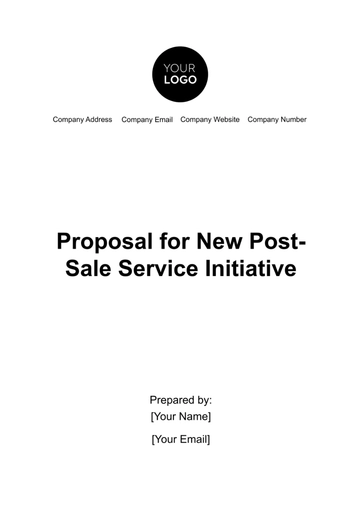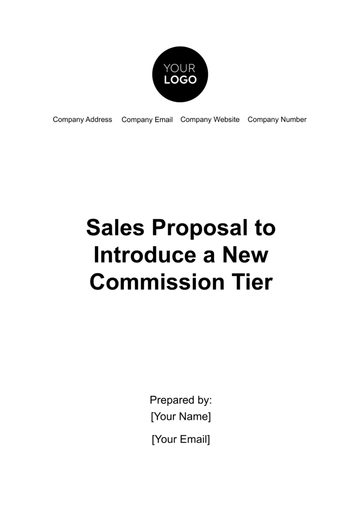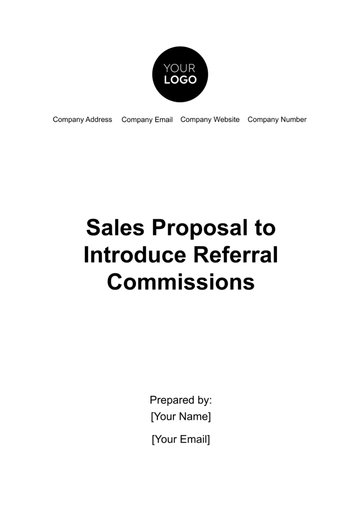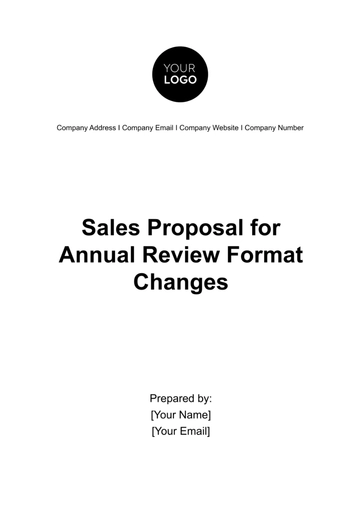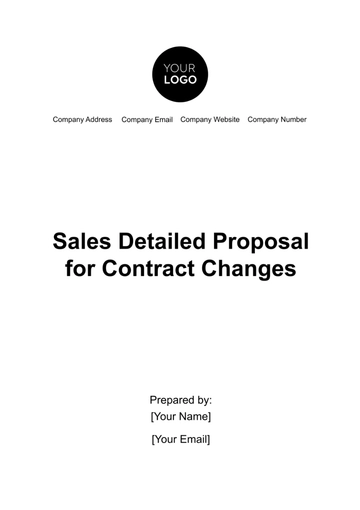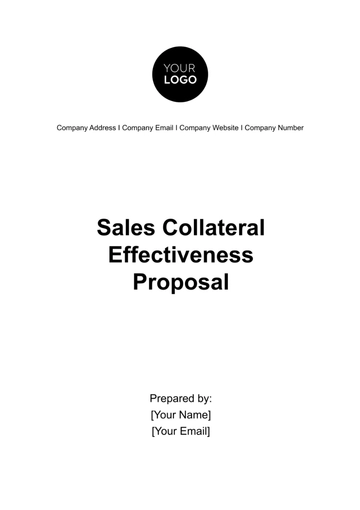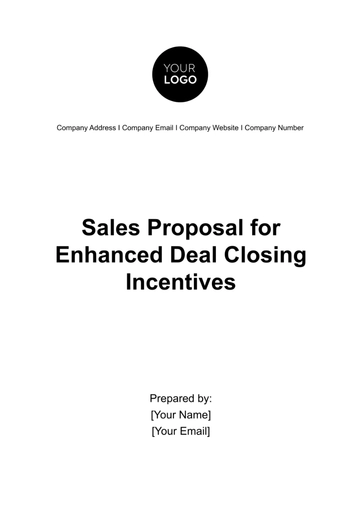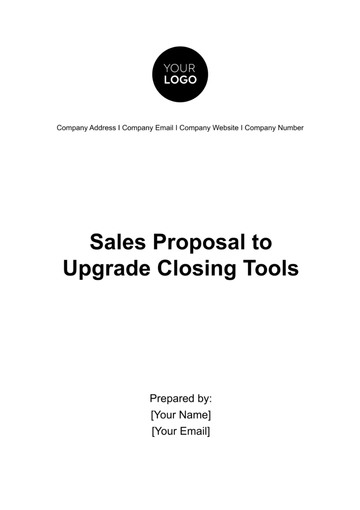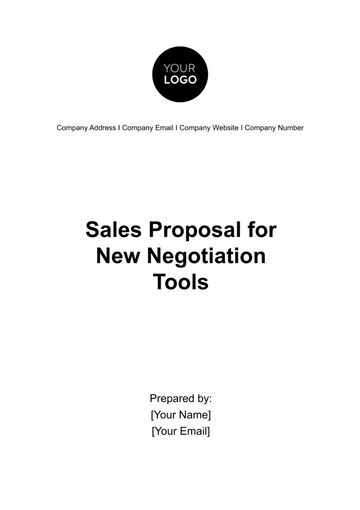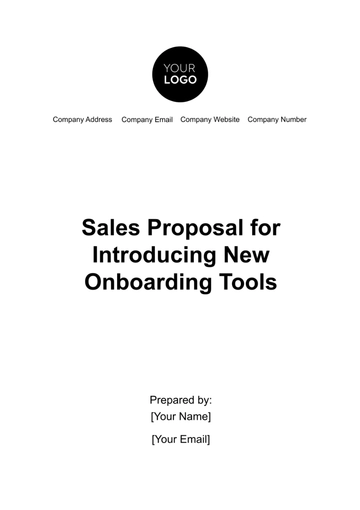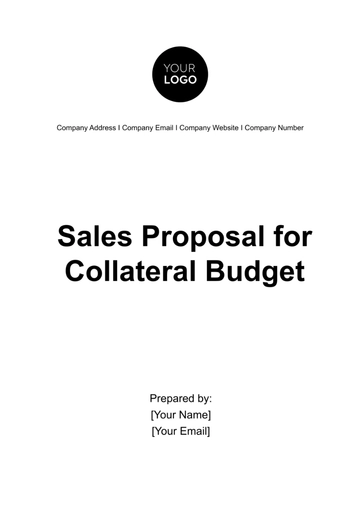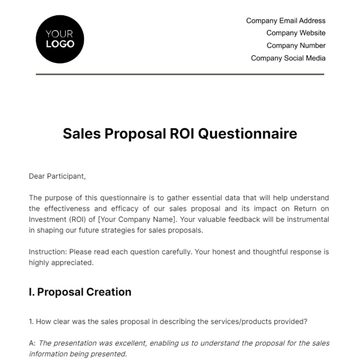Free Sales Proposal Submission Guide
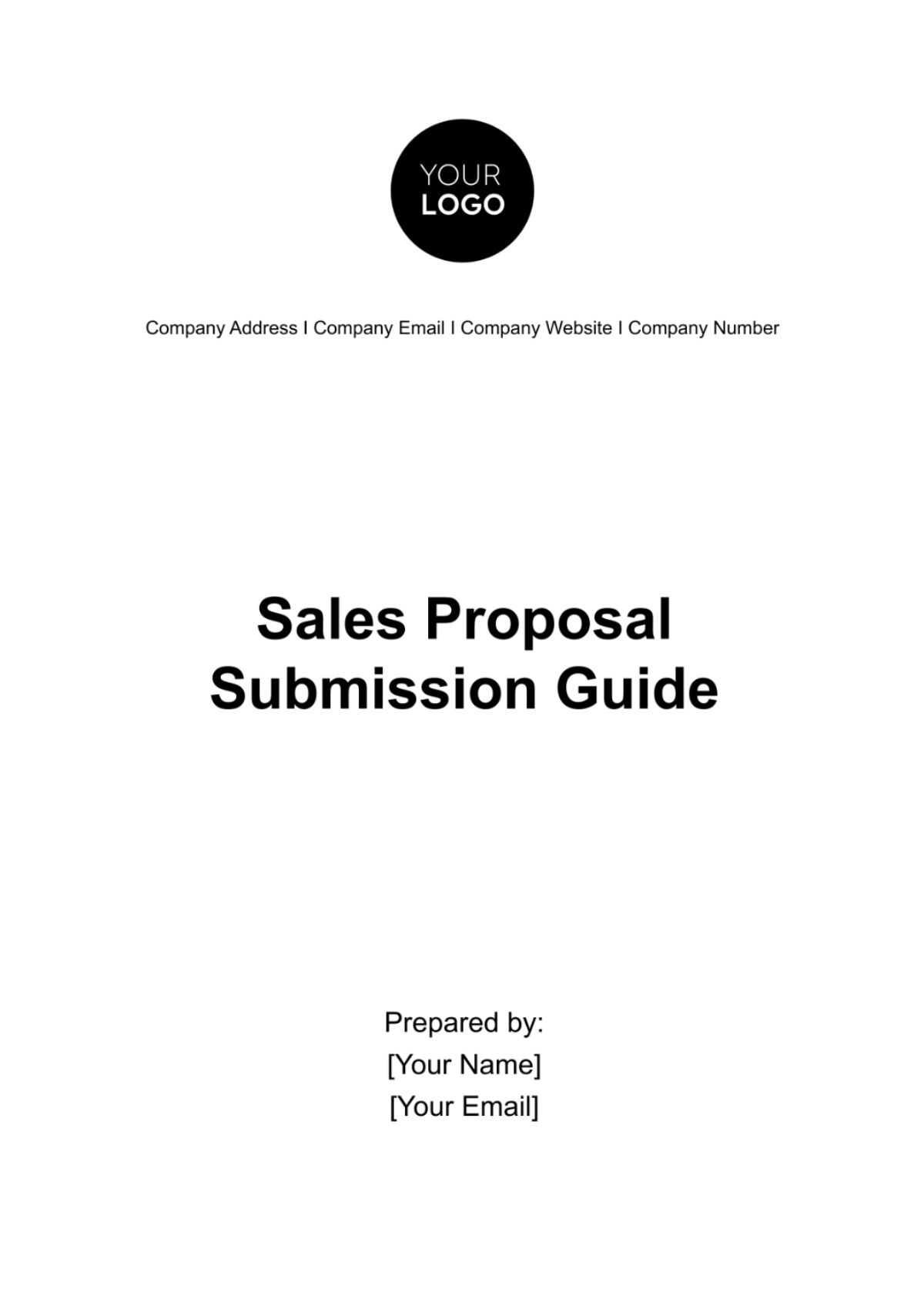
I. INTRODUCTION
Welcome to the Sales Proposal Submission Guide, a comprehensive resource designed to empower you in creating winning sales proposals. In the highly competitive business landscape, a well-crafted proposal can be the key to securing new clients and growing your business. This guide is your roadmap to success, offering insights, strategies, and best practices to set you on the path to sales excellence.
In today's fast-paced business world, the ability to effectively communicate the value of your products or services is more critical than ever. A sales proposal is your opportunity to demonstrate how your offerings can address the unique needs and challenges of your prospective clients. It serves as a bridge between your initial contact and a mutually beneficial partnership. Whether you're a seasoned sales professional or a newcomer to the field, this guide will provide you with the knowledge and tools necessary to create persuasive proposals that consistently close deals.
II. PREPARING YOUR PROPOSAL
A successful sales proposal begins long before you put pen to paper or fingers to keyboard. Preparation is the foundation of an effective proposal. The success of your proposal depends on a clear understanding of your client's needs, your industry, and your own business's strengths and weaknesses.
For [Your Company Name], this means conducting comprehensive research into the industries you serve and the specific pain points your clients are experiencing. Consider the following key steps in proposal preparation:
Client Research: Start by understanding your potential client. What are their goals, challenges, and current pain points? What are their industry trends and preferences? This information will guide your proposal's customization.
Competitive Analysis: Assess your competitors and what sets your services or products apart. Highlight your unique selling points (USPs) and illustrate why you are the best choice.
Industry Expertise: Showcase your industry expertise. For instance, if you serve the healthcare industry, highlight your knowledge of healthcare regulations, privacy concerns, and specific solutions tailored to the healthcare sector.
Needs Assessment: Collaborate with your client to gain a deep understanding of their specific needs. This not only demonstrates your commitment but also tailors the proposal to their exact requirements.
Tailoring the Proposal: Tailor your proposal to address the individual client's pain points and goals. Ensure that your solutions align perfectly with what they need, making it a solution that's hard to resist.
By investing time in thorough preparation, you set the stage for a compelling, personalized proposal that resonates with your prospective client. Your potential client should feel that your proposal is not just a generic document but a tailored solution to their unique challenges and opportunities. This level of effort can significantly increase your chances of a successful proposal submission.
III. PROPOSAL COMPONENTS
In this section, we emphasize the importance of identifying the different types of a sales proposal. Here they are detailed in the table below:
PROPOSAL COMPONENT | DESCRIPTION |
Executive Summary | A concise, compelling introduction summarizing your proposal's key points and value proposition. |
Company Background | Information about your company, its history, mission, and relevant accomplishments. |
Proposed Solution | The core of your proposal, outlining the specific products or services you're offering to the client. |
Benefits and Features | Highlight the advantages and unique features of your offering, demonstrating its relevance to the client. |
Testimonials or Case Studies | Real-world examples of successful outcomes for similar clients, instilling trust and confidence. |
Pricing and Packages | Transparent and competitive pricing options for the client to choose from, along with any special deals. |
Timeline and Deliverables | A detailed schedule and the specific items the client can expect during and after the engagement. |
Terms and Conditions | Legal or contractual information, including payment terms, warranties, and any relevant policies. |
Call to Action | A clear and persuasive statement encouraging the client to take the next steps, such as signing the contract. |
IV. CUSTOMIZING FOR DIFFERENT BUSINESSES
Adapting your proposal for various businesses and industries is essential to resonate with your diverse clientele. One size does not fit all, and by taking the time to customize your proposals, you significantly increase your chances of success. Here are effective strategies for personalization:
Industry Research: Before crafting your proposal, conduct thorough research on the specific industry or business you are targeting. Understand their challenges, trends, and competitive landscape. For example, if you are approaching a healthcare client, familiarize yourself with the latest regulations and healthcare technology trends.
Tailored Value Proposition: Your value proposition should directly address the unique needs of the industry or business. Show how your product or service can solve their particular pain points and help them achieve their goals. If you're targeting a manufacturing company, highlight how your solutions can improve efficiency and reduce operational costs.
Language and Tone: Adjust the language and tone of your proposal to match the industry's culture. A proposal for a creative agency may use a more informal and creative tone, while a proposal for a financial institution should maintain a formal and professional tone.
Relevant Case Studies: Include case studies or success stories that are relevant to the industry. Demonstrate how your solutions have benefitted similar businesses, increasing your credibility. For instance, when targeting a retail client, showcase successful outcomes with previous retail clients.
Industry-Specific Metrics: Incorporate industry-specific metrics and key performance indicators (KPIs) to demonstrate your understanding of their business. If you are approaching a technology company, discuss uptime, system reliability, and cybersecurity measures.
Address Regulatory Compliance: Industries like finance and healthcare have strict regulatory requirements. Ensure that your proposal addresses compliance and security concerns. Show how your solutions can help the client meet these regulations.
Personalized Introduction: Begin your proposal with a personalized introduction that references the recipient's industry or business. This demonstrates your attention to detail and genuine interest in working with them.
Highlight Competitive Advantage: Emphasize how your product or service provides a competitive advantage within their specific industry. For a client in the hospitality sector, showcase how your solutions enhance guest experiences and increase revenue.
V. PRICING AND VALUE PROPOSITION
Pricing and articulating a compelling value proposition are pivotal components of any successful sales proposal. Here, we delve into strategies for determining the right pricing and effectively communicating the unique value your offering brings.
Determining Competitive Pricing Strategies
When setting the price for your products or services, it's essential to strike a balance between competitiveness and profitability. Begin by researching your industry standards and competitors' pricing. Consider the cost of production, overheads, and desired profit margins. Competitive pricing means offering technology solutions at a rate that aligns with market norms while ensuring sustainability.
Communicating the Unique Value Proposition
Your value proposition is the promise of value that your clients will receive from your product or service. It's crucial to clearly convey how your offering addresses your client's specific pain points and provides benefits that competitors cannot. For [Your Company Name], the value proposition might emphasize expertise in technology solutions tailored to healthcare needs, highlighting how their services can improve patient care and operational efficiency.
Your value proposition should encompass:
Solving a Problem: Explain how your product or service addresses the client's challenges or needs. Use real-world examples and case studies to illustrate your solutions.
Key Benefits: Enumerate the benefits of choosing your offering over competitors, such as cost savings, increased efficiency, or improved quality.
Unique Features: Highlight any unique features or aspects of your product that set it apart from alternatives. This might include patented technology, a dedicated support team, or industry-specific certifications.
Customer Testimonials: Incorporate positive feedback or testimonials from satisfied clients who've experienced the value of your solution.
Return on Investment (ROI): If relevant, provide data or projections demonstrating the financial benefits of your offering, showcasing a quick payback period or high ROI.
Remember that the value proposition should be customer-centric and tailored to the specific needs and pain points of the client you're addressing. It's not a one-size-fits-all approach but rather a dynamic element that evolves with each proposal to speak directly to the recipient's objectives.
VI. PRESENTATION AND FORMATTING
The visual presentation and organization of your sales proposal play a critical role in making a positive impression on your potential clients. Whether you're a technology company like or a consulting firm, a well-structured and visually appealing proposal will increase your chances of success.
Organizing Your Proposal
Cover Page: Begin with an eye-catching cover page. It should include your company's logo, the proposal title, and the date of submission. Ensure that the design aligns with your brand's aesthetics.
Table of Contents: Include a table of contents to guide your reader through the proposal's sections. This allows them to find specific information quickly.
Executive Summary: Reiterate the most compelling aspects of your proposal. This is your chance to summarize the key points concisely and entice the reader to continue.
Company Background: Provide a brief history and mission of your company. Explain why your business is uniquely positioned to address the client's needs.
Proposed Solution: Describe your offering in detail. Use clear, concise language, and consider using visuals like charts and graphs to illustrate complex concepts.
Visual Appeal
Graphics and Visuals: Incorporate relevant graphics, images, charts, and graphs to break up the text and make the proposal visually engaging. Ensure that all visuals are of high quality.
Consistent Branding: Maintain consistent branding throughout the proposal. This includes using your company's official colors, fonts, and logos. Consistency conveys professionalism.
Use of White Space: Avoid overcrowding pages with text. Adequate white space makes your content more readable and accessible.
Font and Typography: Select legible fonts that are easy to read, even when printed. Common choices include Arial, Calibri, or Times New Roman.
Clarity and Structure
Logical Flow: Organize your proposal logically, with a clear beginning, middle, and end. Each section should naturally lead to the next.
Headings and Subheadings: Use descriptive headings and subheadings to guide the reader and improve navigation. They also break up the content for easier comprehension.
Bullet Points and Lists: Utilize bullet points and numbered lists for highlighting key information, benefits, or features. They help emphasize important details.
Consistency in Language: Maintain consistency in your language and tone throughout the proposal. Avoid jargon or acronyms that the client might not be familiar with.
Accessibility and Readability
File Format: Consider the format in which you'll deliver your proposal. PDFs are generally a safe choice, but be mindful of any format preferences the client may have.
File Size: Ensure that the file size is manageable. Large files may be challenging to download and view.
Mobile Responsiveness: As more people access documents from mobile devices, ensure that your proposal is readable and visually appealing on smartphones and tablets.
VII. QUALITY ASSURANCE AND REVIEW
Quality assurance and review are critical steps in the proposal submission process. A well-polished and error-free proposal not only reflects professionalism but also instills confidence in the recipient.
Proofreading
Before considering external feedback, start by proofreading your proposal meticulously. Here are some tips to guide you:
Take Your Time: Set aside dedicated time for proofreading, ensuring you're focused and not rushed.
Read Aloud: Read the proposal aloud to catch grammatical errors, awkward sentences, and unclear phrasing.
Grammar and Spelling: Check for correct grammar, spelling, and punctuation throughout the document.
Consistency: Ensure consistency in language, style, and formatting.
Acronyms and Abbreviations: Define and explain any industry-specific acronyms or abbreviations.
Factual Accuracy: Verify that all facts, statistics, and references are accurate.
Editing
Editing goes beyond proofreading and involves a critical evaluation of the content, structure, and overall flow of your proposal. Here's how to approach the editing process:
Clarity and Conciseness: Ensure that your proposal is clear and concise. Remove unnecessary jargon and complex language.
Message Alignment: Verify that your proposal aligns with the client's specific needs and challenges, adjusting content if necessary.
Relevance: Assess each section's relevance. Eliminate anything that doesn't contribute to the main message.
Logical Flow: Check the logical flow of the proposal. Is the sequence of information easy for the reader to follow?
Visual Elements: Review any charts, graphs, or visual elements to ensure they support your message effectively.
Call to Action: Ensure your call to action is clear and compelling.
Seeking Feedback and Conducting a Final Review
While self-review is important, receiving feedback from others is equally valuable. Here's how to involve others in the review process:
Peer Review: Ask colleagues or team members to review your proposal. They can provide valuable insights and catch errors you might miss.
Mentor Input: If possible, consult with a mentor or a more experienced professional in your field for guidance.
Client Perspective: If appropriate, reach out to colleagues or associates who can represent the client's perspective.
Final Review: After incorporating feedback, conduct a final review to ensure all changes have been made and that your proposal is ready for submission.
VIII. SUBMISSION AND FOLLOW-UP
Preparing a persuasive sales proposal is only half the battle; delivering it effectively and following up can make all the difference in closing the deal.
Submission Best Practices
Timely Delivery: Ensure your proposal reaches the client well before the deadline. Punctuality demonstrates professionalism and dedication.
Preferred Format: Confirm the preferred format for proposal submission (e.g., PDF, Word, online portal). Adhering to the client's preferred format makes their review process smoother.
Attention to Detail: Before sending your proposal, double-check for errors, such as typos or formatting issues. Attention to detail reflects positively on your professionalism.
Cover Letter: Accompany your proposal with a well-crafted cover letter. This is your opportunity to provide a personal touch, summarizing the proposal's key points and expressing enthusiasm for the collaboration.
Delivery Confirmation: After sending the proposal, request a delivery confirmation or receipt acknowledgment to ensure the client has received it.
Post-Submission Communication Strategies
Initial Follow-Up: Within a few days of submitting your proposal, initiate a follow-up communication. Express appreciation for the opportunity and inquire if the client has any initial questions or concerns. This proactive approach demonstrates your commitment and willingness to address their needs promptly.
Clarification Meeting: Offer to schedule a meeting or call to clarify any aspects of the proposal or answer any questions. This is a crucial step in nurturing a potential client relationship and ensuring they fully understand your offering.
Client's Decision Timeline: Politely inquire about the client's expected decision timeline. Understanding their schedule can help you plan follow-up communications accordingly.
Feedback Solicitation: Encourage the client to provide feedback on the proposal. Their insights can be invaluable for improving future proposals and tailoring your services to their needs.
Subsequent Follow-Ups: Depending on the client's response, craft a follow-up schedule that respects their decision-making process. Regular, non-intrusive follow-ups convey your ongoing interest while allowing the client the space they need to make their decision.
Alternative Offers: If the client expresses hesitancy or specific concerns, be prepared to discuss potential alternative solutions. Flexibility in your approach can win over clients with unique needs.
Recording and Tracking
Keep a detailed record of all communications related to the proposal, including dates, times, and outcomes of interactions. Using a Customer Relationship Management (CRM) system can help you manage this efficiently. Tracking your interactions ensures you stay organized and can pick up the conversation seamlessly in follow-up interactions.
IX. CONCLUSION
In the process of mastering the art of proposal submission, we've covered essential facets, from meticulous preparation to the post-submission follow-up. This journey has been guided by the aim of not only getting your foot in the door but establishing enduring relationships with clients.
Throughout this guide, you've acquired the knowledge to transform your proposals into compelling narratives that resonate with potential clients, showing them not just what you offer but why they need it. Let's recap the key takeaways:
Tailoring for Success: Every proposal is a unique opportunity. Tailoring your approach for each recipient, whether it's a healthcare institution, a tech startup, or a manufacturing company, is the first step to success.
Crafting the Compelling Executive Summary: Your executive summary should be a captivating story opener. Highlight your unique selling points and key benefits to grab your reader's attention from the outset.
Pricing with Precision: Striking the right balance between competitive pricing and your unique value proposition is an art. Demonstrating how your solution offers more value than your competitors is key.
Making It Visually Appealing: A well-organized, visually appealing proposal can be a deal-maker. Enhance readability with clear headings, bullet points, and visuals where appropriate.
Quality Assurance and Review: Polish your proposals to perfection by meticulously proofreading and editing. Involve peers or mentors to gain valuable feedback and improve the clarity and persuasiveness of your proposals.
Effective Follow-Up: The journey doesn't end with submission. Smart follow-up strategies can keep the conversation alive, nurturing leads into clients and transforming transactions into long-lasting partnerships.
As you embark on your proposal submission endeavors, keep in mind that each proposal is not just a document but an opportunity. Whether you're presenting services, products, or solutions, your proposals should aim to address the unique needs and aspirations of your prospective clients.
The success of your proposal submissions hinges on continuous learning, adaptation, and a genuine commitment to understanding your clients. Armed with this guide, you have the tools to create proposals that not only win business but also build trust and foster mutually beneficial relationships.
- 100% Customizable, free editor
- Access 1 Million+ Templates, photo’s & graphics
- Download or share as a template
- Click and replace photos, graphics, text, backgrounds
- Resize, crop, AI write & more
- Access advanced editor
Unlock the art of persuasive sales proposals effortlessly with our Sales Proposal Submission Guide Template from Template.net. This editable and customizable template, powered by our innovative AI Editor Tool, streamlines your process. Craft compelling proposals that captivate clients, ensuring your submissions stand out. Elevate your sales game with this essential tool in your arsenal.
You may also like
- Business Proposal
- Research Proposal
- Proposal Request
- Project Proposal
- Grant Proposal
- Photography Proposal
- Job Proposal
- Budget Proposal
- Marketing Proposal
- Branding Proposal
- Advertising Proposal
- Sales Proposal
- Startup Proposal
- Event Proposal
- Creative Proposal
- Restaurant Proposal
- Blank Proposal
- One Page Proposal
- Proposal Report
- IT Proposal
- Non Profit Proposal
- Training Proposal
- Construction Proposal
- School Proposal
- Cleaning Proposal
- Contract Proposal
- HR Proposal
- Travel Agency Proposal
- Small Business Proposal
- Investment Proposal
- Bid Proposal
- Retail Business Proposal
- Sponsorship Proposal
- Academic Proposal
- Partnership Proposal
- Work Proposal
- Agency Proposal
- University Proposal
- Accounting Proposal
- Real Estate Proposal
- Hotel Proposal
- Product Proposal
- Advertising Agency Proposal
- Development Proposal
- Loan Proposal
- Website Proposal
- Nursing Home Proposal
- Financial Proposal
- Salon Proposal
- Freelancer Proposal
- Funding Proposal
- Work from Home Proposal
- Company Proposal
- Consulting Proposal
- Educational Proposal
- Construction Bid Proposal
- Interior Design Proposal
- New Product Proposal
- Sports Proposal
- Corporate Proposal
- Food Proposal
- Property Proposal
- Maintenance Proposal
- Purchase Proposal
- Rental Proposal
- Recruitment Proposal
- Social Media Proposal
- Travel Proposal
- Trip Proposal
- Software Proposal
- Conference Proposal
- Graphic Design Proposal
- Law Firm Proposal
- Medical Proposal
- Music Proposal
- Pricing Proposal
- SEO Proposal
- Strategy Proposal
- Technical Proposal
- Coaching Proposal
- Ecommerce Proposal
- Fundraising Proposal
- Landscaping Proposal
- Charity Proposal
- Contractor Proposal
- Exhibition Proposal
- Art Proposal
- Mobile Proposal
- Equipment Proposal
- Student Proposal
- Engineering Proposal
- Business Proposal
